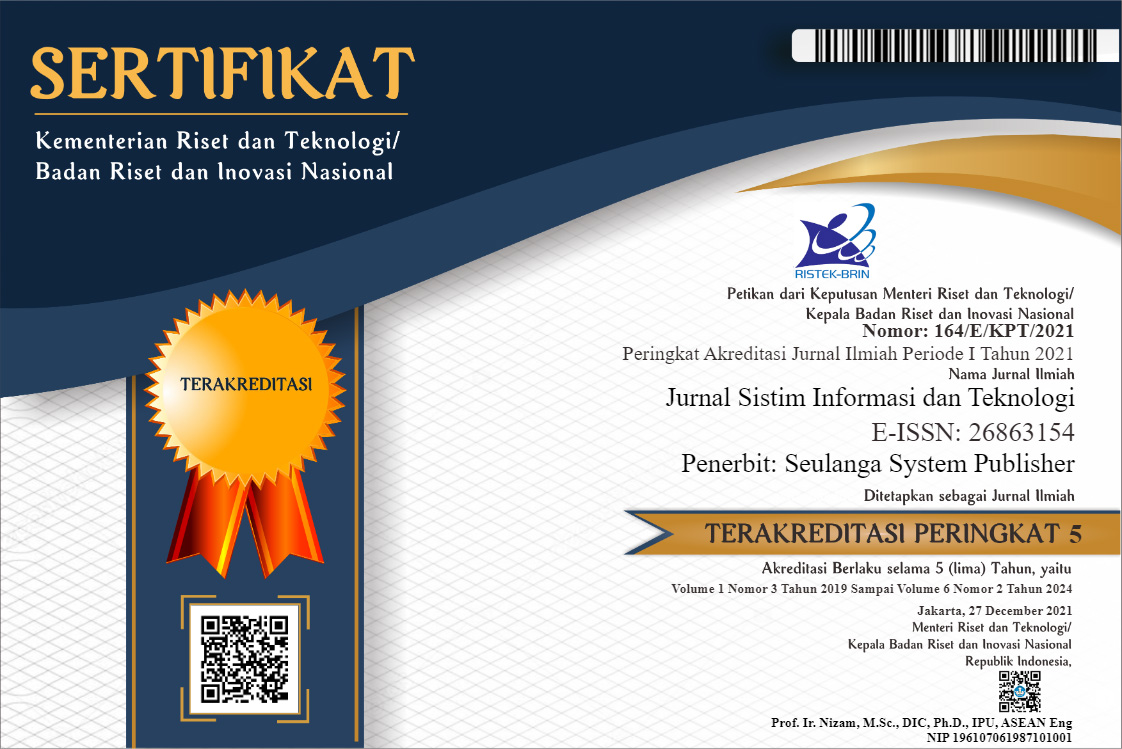Digital Bank User Acceptance Analysis Using The Extended Technology Acceptance Model
DOI:
https://doi.org/10.60083/jsisfotek.v5i3.281Keywords:
Electronic Payments, Digital Transformation, Technology Acceptance Model, Digital BankAbstract
The Covid-19 pandemic requires banks to provide electronic payments, carry out digital transformation and open up opportunities for financial technology-based companies. Digital transformation in banking requires reliable integration and security between systems. Otherwise, it can become a gap for cyber attacks. Cyber security in banking includes Confidentiality, Integrity, Availability, Non-repudiation, and Authentication. Jenius is the first digital bank in Indonesia that makes it easy for customers to complete transactions and manage finances digitally without going to the bank. This bank was once a victim of a cyber attack that attacked customers with material losses of around 50 billion and non-material losses in the form of decreased bank credibility. Digital Bank also has problems that often occur, such as failing to identify customers, differences in facts on proof of transfer, frequent force close applications, etc. This study aims to determine the effect of security on behavioral intention and other factors that influence behavioral choice in this digital bank using the modified Technology Acceptance Model (TAM) model. The variables used are Confidentiality, Integrity, Availability, Non-repudiation, Authentication, Perceived Security, Perceived usefulness (PU), Perceived Trust, Perceived Ease of Use (PEoU), and Behavioral Intentions. This research uses quantitative methodology by distributing questionnaires to 200 sample customers. The measurement results show that more than half variables are accepted. The four rejected variables are the Confidentiality, Availability, and Non-repudiation variables to perceived security and the Perceived Ease of Use (PEoU) variable for the trust variable. Future research can add several external variables and review the rejected variables.
References
Alfarizi, M., & Sari, R. K. (2022). Indonesian Digital Bank Adoption Defence Determination Post-Privacy Data Leakage Issues. 2022 7th International Workshop on Big Data and Information Security (IWBIS), 81–88. https://doi.org/10.1109/IWBIS56557.2022.9924813
Alkhaldi, A. N. (2017). An empirical examination of customers’ mobile phone experience and awareness of mobile banking services in mobile banking in Saudi Arabia. Interdisciplinary Journal of Information, Knowledge, and Management, 12(October), 283–308. https://doi.org/10.28945/3887
Sulistyowati, Pahlawansah, H. ., Sumerli A, C. H. ., Octiva, C. S. ., & Muafiqie, H. . (2023). Measurement Analysis of the Level of E-Commerce Adoption Readiness in SMEs Using Technology Readiness Index Method. Jurnal Sistim Informasi Dan Teknologi, 5(2), 193–197.
Baabdullah, A. M., Alalwan, A. A., Rana, N. P., Kizgin, H., & Patil, P. (2019). Consumer use of mobile banking (M-Banking) in Saudi Arabia: Towards an integrated model. International Journal of Information Management, 44(1), 38–52. https://doi.org/10.1016/j.ijinfomgt.2018.09.002
Aji, D. S., Setiawan, Z., Butarbutar, D. J. A., Huanza, M., & ZA, S. Z. (2023). The Influence of Service Convenience and Promotional Strategies on Decisions to Transaction Using QRIS and Its Implications on Customer Loyalty. JEMSI (Jurnal Ekonomi, Manajemen, dan Akuntansi), 9(4), 1417-1422.
Solihin, I., Sujana, F. R., Apriyani, G., Faritsal, A., Anderson Butar Butar, D. J., & Hidayat, R. T. (2022). Behavioral Analysis of SME's Business Plan Preparation Before and After Running a Business: The Case Of Indonesia. Central Asia & the Caucasus (14046091), 23(1).
Carranza, R., Díaz, E., Sánchez-Camacho, C., & Martín-Consuegra, D. (2021). eBanking Adoption: An Opportunity for Customer Value Co-creation. Frontiers in Psychology, 11(January), 1–10. https://doi.org/10.3389/fpsyg.2020.621248
Siregar, A. P., Tannady, H., Jusman, I. A., Cakranegara, P. A., & Arifin, M. S. (2022). Peran Harga Produk Dan Brand Image Terhadap Purchase Decision Produk Cold Pressed Juice Re. Juve. Management Studies and Entrepreneurship Journal (MSEJ), 3(5), 2657-2665.
Cheng, W., & Shi-bo, W. (2014). User behavior research of information security technology based on TAM. International Journal of Security and Its Applications, 8(2), 203–210. https://doi.org/10.14257/ijsia.2014.8.2.21
Fitriani, A., Sfenrianto, Wang, G., & Susanto, A. (2016). Examining the security issues of automated teller machine based on revised technical acceptance model. Telkomnika (Telecommunication Computing Electronics and Control),14(4), 1521–1526. https://doi.org/10.12928/TELKOMNIKA.v14i4.2920
Nurprihatin, F., Octa, A., Regina, T., Wijaya, T., Luin, J., & Tannady, H. (2019). The extension analysis of natural gas network location-routing design through the feasibility study. Journal of applied research on industrial engineering, 6(2), 108-124.
Nurprihatin, F., Lisnati Jayadi, E., & Tannady, H. (2020). Comparing Heuristic Methods' Performancefor Pure Flow Shop Scheduling under Certainand Uncertain Demand. Management and Production Engineering Review, 11(2), 50-61.
Perneger, T. V., Courvoisier, D. S., Hudelson, P. M., & Gayet-Ageron, A. (2015). Sample size for pre-tests of questionnaires. Quality of Life Research, 24(1), 147–151. https://doi.org/10.1007/s11136-014-0752-2
Gunawan, F. E., Wilujeng, F. R., Rembulan, G. D., & Tannady, H. (2020). Service quality analysis of smes tempe in province of Jakarta, Indonesia. Technology Reports of Kansai University, 62(7), 3827-3833.
Downloads
Published
How to Cite
Issue
Section
License
Copyright (c) 2023 Jurnal Sistim Informasi dan Teknologi

This work is licensed under a Creative Commons Attribution 4.0 International License.









